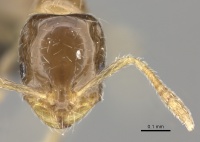Monomorium musicum
| Monomorium musicum | |
|---|---|

| |
| Scientific classification | |
| Kingdom: | Animalia |
| Phylum: | Arthropoda |
| Class: | Insecta |
| Order: | Hymenoptera |
| Family: | Formicidae |
| Subfamily: | Myrmicinae |
| Tribe: | Solenopsidini |
| Genus: | Monomorium |
| Species: | M. musicum |
| Binomial name | |
| Monomorium musicum Forel, 1910 | |
This species has been collected in grasslands.
Identification
Bolton (1987) - A member of the M. boerorum complex in the M. monomorium species group. This minute species is superficially similar to Monomorium braunsi, but in the latter the petiole node is very low and broadly convex dorsally, and the anterior peduncle of the node lacks a prominent anteroventral process. Monomorium torvicte, a close relative of musicum, is uniformly dark brown and has shorter scapes and smaller eyes but is otherwise very similar indeed. I have treated these as separate species for the present but suspect that further collecting may nullify the apparent differences between them.
Keys including this Species
Distribution
Latitudinal Distribution Pattern
Latitudinal Range: -23.68333° to -33.73333°.
| North Temperate |
North Subtropical |
Tropical | South Subtropical |
South Temperate |
- Source: AntMaps
Distribution based on Regional Taxon Lists
Afrotropical Region: South Africa (type locality).
Distribution based on AntMaps
Distribution based on AntWeb specimens
Check data from AntWeb
Countries Occupied
| Number of countries occupied by this species based on AntWiki Regional Taxon Lists. In general, fewer countries occupied indicates a narrower range, while more countries indicates a more widespread species. |

|
Estimated Abundance
| Relative abundance based on number of AntMaps records per species (this species within the purple bar). Fewer records (to the left) indicates a less abundant/encountered species while more records (to the right) indicates more abundant/encountered species. |

|
Biology
Castes
Worker
Images from AntWeb
   
| |
| Syntype of Monomorium oscaris musicum. Worker. Specimen code casent0902258. Photographer Will Ericson, uploaded by California Academy of Sciences. | Owned by NHMUK, London, UK. |
Nomenclature
The following information is derived from Barry Bolton's Online Catalogue of the Ants of the World.
- musicum. Monomorium oscaris subsp. musicum Forel, 1910e: 442 (w.q.) SOUTH AFRICA.
- Type-material: syntype workers (number not stated), 1 syntype queen.
- Type-locality: South Africa: Natal, no. 156 (Haviland).
- Type-depositories: BMNH, MHNG.
- Subspecies of oscaris: Arnold, 1916: 230; Wheeler, W.M. 1922a: 865; Ettershank, 1966: 91.
- Status as species: Emery, 1922e: 173; Bolton, 1987: 402 (redescription); Bolton, 1995b: 264.
- Distribution: South Africa.
Unless otherwise noted the text for the remainder of this section is reported from the publication that includes the original description.
Description
Worker
Bolton (1987) - TL 1.6-1.7, HL 0.42-0.44, HW 0.32-0.33, CI 73-76, SL 0.26-0.27, SI 81-84, PW 0.20-0. 22, AL 0.40-0.42 (3 measured).
Clypeal carinae narrow but sharply defined posteriorly, divergent anteriorly and tending to fade out before reaching the anterior margin. Prominent median portion of clypeus transverse on its anterior margin and with an obtuse angle separating the anterior and lateral margins, but without projecting teeth or denticles. Maximum diameter of eye 0.22-0.24 x HW and with 6 ommatidia in the longest row. With the head in full-face view the eyes very obviously far in front of the midlength of the sides. Antennal scapes, when laid straight back from their insertions, falling far short of the occipital margin. Sides of head shallowly convex and divergent posteriorly, so that the width of the head at the occipital margin is greater than its width immediately in front of the eyes. Occipital margin broad and weakly concave medially. Promesonotum in profile low, scarcely higher than the highest point of the propodeum. Dorsum of promesonotum more or less flat in profile, downcurved anteriorly to the cervix and posteriorly to the narrow and weakly impressed metanotal groove; the latter with few short inconspicuous cross-ribs. Propodeal dorsum highest immediately behind the metanotal groove, the dorsum then rounding evenly into the declivity through a broad smooth curve. Propodeal spiracle small. Petiole node low subconical in profile, with a short anterior peduncle which is subtended by a small subtriangular and flange-like anteroventral process. Postpetiole much smaller than petiole, its dorsum low and evenly convex. All dorsal surfaces of head and body with standing hairs, 3-4 pairs present on the promesonotum. Sculpture absent except for minute hair-pits and metanotal cross-ribs. Colour yellow, the head and gaster of some individuals with a faint brownish tint.
Type Material
Bolton (1987) - Syntype workers, female, South Africa: Natal no. 156 (Haviland) (Musee d'Histoire Naturelle Genève; The Natural History Museum) [examined].
References
- Bolton, B. 1987. A review of the Solenopsis genus-group and revision of Afrotropical Monomorium Mayr (Hymenoptera: Formicidae). Bulletin of the British Museum (Natural History). Entomology. 54:263-452.. (page 402, Raised to species)
- Emery, C. 1922c. Hymenoptera. Fam. Formicidae. Subfam. Myrmicinae. [part]. Genera Insectorum 174B: 95-206 (page 173, Raised to species)
- Forel, A. 1910f. Note sur quelques fourmis d'Afrique. Ann. Soc. Entomol. Belg. 54: 421-458 (page 442, worker, queen described)
References based on Global Ant Biodiversity Informatics
- Arnold G. 1916. A monograph of the Formicidae of South Africa. Part II. Ponerinae, Dorylinae. Annals of the South African Museum. 14: 159-270.
- Bolton B. 1987. A review of the Solenopsis genus-group and revision of Afrotropical Monomorium Mayr (Hymenoptera: Formicidae). Bulletin of the British Museum (Natural History). Entomology 54: 263-452.
- Ettershank G. 1966. A generic revision of the world Myrmicinae related to Solenopsis and Pheidologeton (Hymenoptera: Formicidae). Aust. J. Zool. 14: 73-171.
- Forel A. 1910. Note sur quelques fourmis d'Afrique. Annales de la Société Entomologique de Belgique 54: 421-458.

